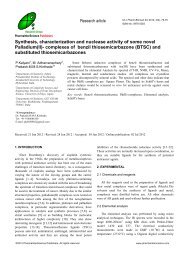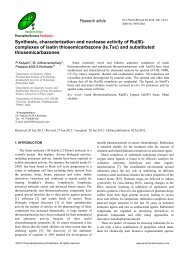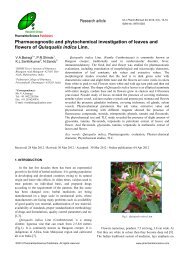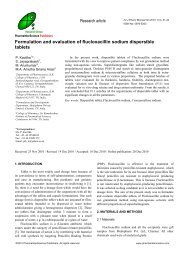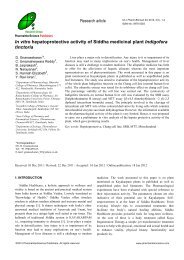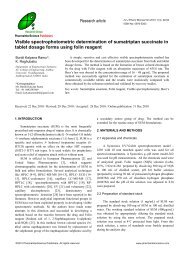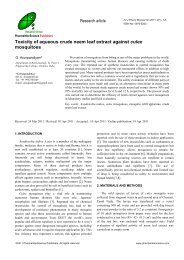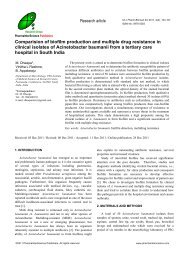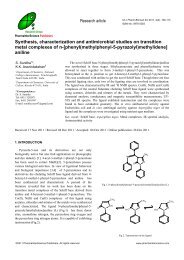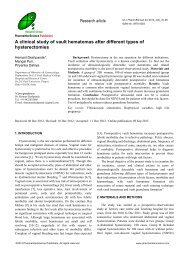Development and validation of a stability-indicating HPTLC method ...
Development and validation of a stability-indicating HPTLC method ...
Development and validation of a stability-indicating HPTLC method ...
You also want an ePaper? Increase the reach of your titles
YUMPU automatically turns print PDFs into web optimized ePapers that Google loves.
Dinesh Kumar Jain et al., Int J Pharm Biomed Sci 2011, 2(2), 55-6059Table 3Assay result <strong>of</strong> marketed formulationS. No. Actual concentration (mg) Concentration found (mg) % ContentLOR PCM LOR PCM LOR PCM1 300 400 302.43±4.22 400.31±1.64 101.02±1.34 100.08±1.92Table 4Forced degradation studiesSample exposure conditions LOR PCMNumber <strong>of</strong> degradation products % Recovery (n=3) Number <strong>of</strong> degradation products % Recovery (n=3)(R f value)(R f value)1 M HCl,8h, RT 3 (0.28,0.72, 0.88) 89.23 ±2.17 2 (0.75,0.88) 96.02 ±3.541 M NaOH, 8h, RT 4 (0.01,0.04, 0.72,0.88) 79.0 ±2.94 1(0.4) 76.05 ±1.3710%,H 2 O 2 , 8h, RT 2 (0.71,0.87) 74.34 ±7.15 2(0.40,0.64) 75.14 ±0.82Sunlight, 8h 1(0.76) 45.2 ±1.91 1 (0.79) 13.53 ±1.31Heat, 3h, 55°C 2 (0.31,0.75) 99.67 ±2.43 2 (0.76,0.96) 93.75 ±0.84a) b)Fig.4. <strong>HPTLC</strong> chromatogram obtained from forced degradation studies (a) acid degradation (1 M HCl, 8h, RT) showing 3 degradants at R f values 0.28, 0.72,0.88 for LOR <strong>and</strong> 2 degradants at R f values 0.75, 0.88 for PCM <strong>and</strong> (b) base degradation (1 M NaOH, 8h, RT) showing 4 degradants at R f values 0.01, 0.04,0.72, 0.88 for LOR <strong>and</strong> 1 degradant at R f value 0.4 for PCMseparation was obtained at 290 nm (Fig.2). The systemsuitability test parameters are shown in Table 1.In the development <strong>of</strong> <strong>HPTLC</strong> <strong>method</strong>, the mixture <strong>of</strong>chlor<strong>of</strong>orm:methanol:ethyl acetate:ammonia (20:15:55:10, %v/v/v/v) was selected as a mobile phase as it could resolveLOR <strong>and</strong> PCM spots with a better peak shape <strong>and</strong> <strong>of</strong>fered anoptimum separation at R f 0.23 ± 0.01 <strong>and</strong> 0.60 ± 0.02 (n=6)for LOR <strong>and</strong> PCM respectively (Fig.3a).Linear correlation was obtained in the range <strong>of</strong> 2-10μg/mL <strong>and</strong> 5-100 μg/mL for the HPLC <strong>method</strong> <strong>and</strong> 300-550ng/b<strong>and</strong> <strong>and</strong> 100-500 ng/b<strong>and</strong> for <strong>HPTLC</strong> <strong>method</strong> for LOR<strong>and</strong> PCM, respectively. The average linear regressionequation was represented as Y = 10.348X + 1226.7 for LOR,<strong>and</strong> Y = 4.665X + 137.04 for PCM, where X is theconcentration <strong>of</strong> drug <strong>and</strong> Y is the peak area. The overlayspectra <strong>of</strong> LOR, PCM are shown in Fig.3b. The repeatability<strong>of</strong> the <strong>method</strong> was checked by spotting 4 μL <strong>of</strong> a combinedst<strong>and</strong>ard solution six times on the plate (n= 6); the RSD forthe peak area was found to be 0.72 <strong>and</strong> 1.2 for LOR <strong>and</strong>PCM using HPLC <strong>and</strong> 1.24 <strong>and</strong> 1.02 for LOR <strong>and</strong> PCM for<strong>HPTLC</strong>. The intra-day <strong>and</strong> inter-day The RSD values werefound to be




